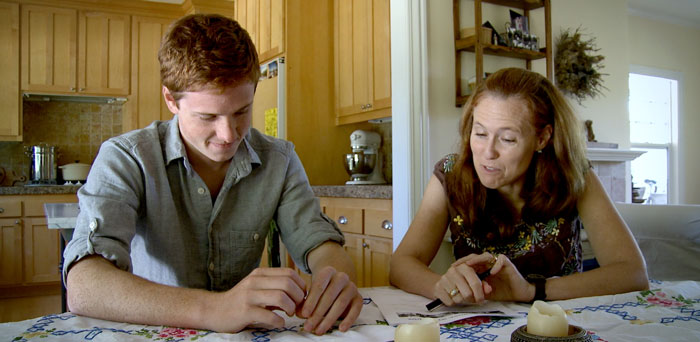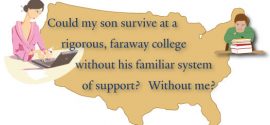Navigating School with a Dyslexic Child: One Mom’s Story
By Kyle Redford, teacher and mother

It is often said that behind every successful dyslexic is an invested and persistent mother (or parent). Not only do I fit the description, but I taught at my son’s school until he was in eighth grade. Yet despite these and other unique advantages, my son’s educational journey was still extraordinarily difficult.
Moving from one’s notion of the ideal child to the real one is a common challenge for many parents, but parents of dyslexic children are hit early and hard with the reality that almost everything to do with learning in the early grades is particularly difficult for their children. I wish I could say that being a teacher allowed me to be more clear-eyed and gracious about my son’s challenges, but that was not the case. In fact, I clung to the ideal version of my son as long as “experts” would indulge it—even though a part of me knew better. My son, Dylan, like many other dyslexic children, went to great lengths to disguise his challenges. He employed his excellent oral vocabulary, sophisticated humor and emotional intelligence to keep us all distracted from the thing that privately shamed and haunted him: Dylan thought he was stupid.
Perhaps the most defining characteristic of dyslexia is the confusion that surrounds the condition. When Dylan could not learn to read in first grade, even with the help of my tortuous nighttime supplementary reading lessons, we had him tested. When we asked the evaluator if Dylan was dyslexic, she dismissed us by explaining that he was much too young for such a diagnosis and that we would have to wait until third grade.
Dylan came of age during an educational renaissance. Over the last two decades, educators have learned that there are effective interventions for learning problems like dyslexia that used to merely carry scary names. We have also learned that dyslexia can be identified early, and there are effective evidence-based reading methods to ensure that children with dyslexia CAN learn to read. Apparently, Dylan’s evaluator hadn’t received that memo. Dylan had to wait until fourth grade to learn to read.
One particularly damaging misunderstanding of the condition is the belief that students who suffer with dyslexia possess diminished academic potential. Many people—teachers included—think that students who require adaptations and adjusted expectations related to reading speed, spelling accuracy and their mode of written expression (laptop vs. handwriting) must also necessitate adjusted intellectual expectations. This is a big error. Dyslexia is a mechanical disability, not a thinking disability. Teachers need to communicate this, parents need to understand this, and—most of all—dyslexic students need to know this. With specialized reading instruction and basic accommodations, dyslexic learners at any school can become engaged, high-performing students. Our son required specialized instruction and accommodations throughout school, and because of those supports, he was able to not only survive, but thrive academically. School got easier every year as the emphasis shifted from learning mechanics to cultivating higher order thinking skills like understanding concepts, making connections and problem-solving. Dylan might have had trouble spelling a country’s name, but he had no trouble understanding how a country’s geographical location impacted its culture and economy.
My son will say that one of the most important decisions he made as a dyslexic student was to embrace the diagnosis. I remember when he first heard the name. He actually loved the label. He felt it contained the condition. He reveled in the realization that dyslexia didn’t make him stupid. It was a specific learning glitch, but it didn’t impact his entire brain. His new intellectual confidence was also boosted as everyone he knew rushed him with stories of successful inventors, entrepreneurs, writers, filmmakers, doctors, lawyers, politicians, scientists, etc., who were members of his new club. Naming dyslexia deshamed and demystified the condition for him.
Tragically, with all we know about dyslexia today, too many educators still whisper the word, too few students get identified early, and many don’t get identified at all. One in five students has dyslexia. Why isn’t there more urgency about the issue? My son’s story may demonstrate that dyslexia doesn’t have to be an academic death sentence, but students shouldn’t require a teacher mom to navigate the system for them, either.
Kyle and her son Dylan are featured in the HBO documentary, “The Big Picture: Rethinking Dyslexia,”
Related

Mother Worry: Academic Support Away from Home
I think it is safe to say that parents of dyslexics worry about their children more than most. There is good reason for this: dyslexic children spend most of their early school dealing with a lot of failure and struggle.
Read MoreTaking Time for Summer Fun
Like all children, dyslexics breathe a sigh of relief when summer begins: no more schoolwork, homework, or assigned books.
Read More
Confessions of a Parent of Two Dyslexics
I am the last person anyone would go to for information about dyslexia.
Read More
The Best Things I Did for My Dyslexic Child
My son has dyslexia. He is now 41 and a successful lawyer, but getting through school, and his academic frustrations, was a challenge we all learned from.
Read More